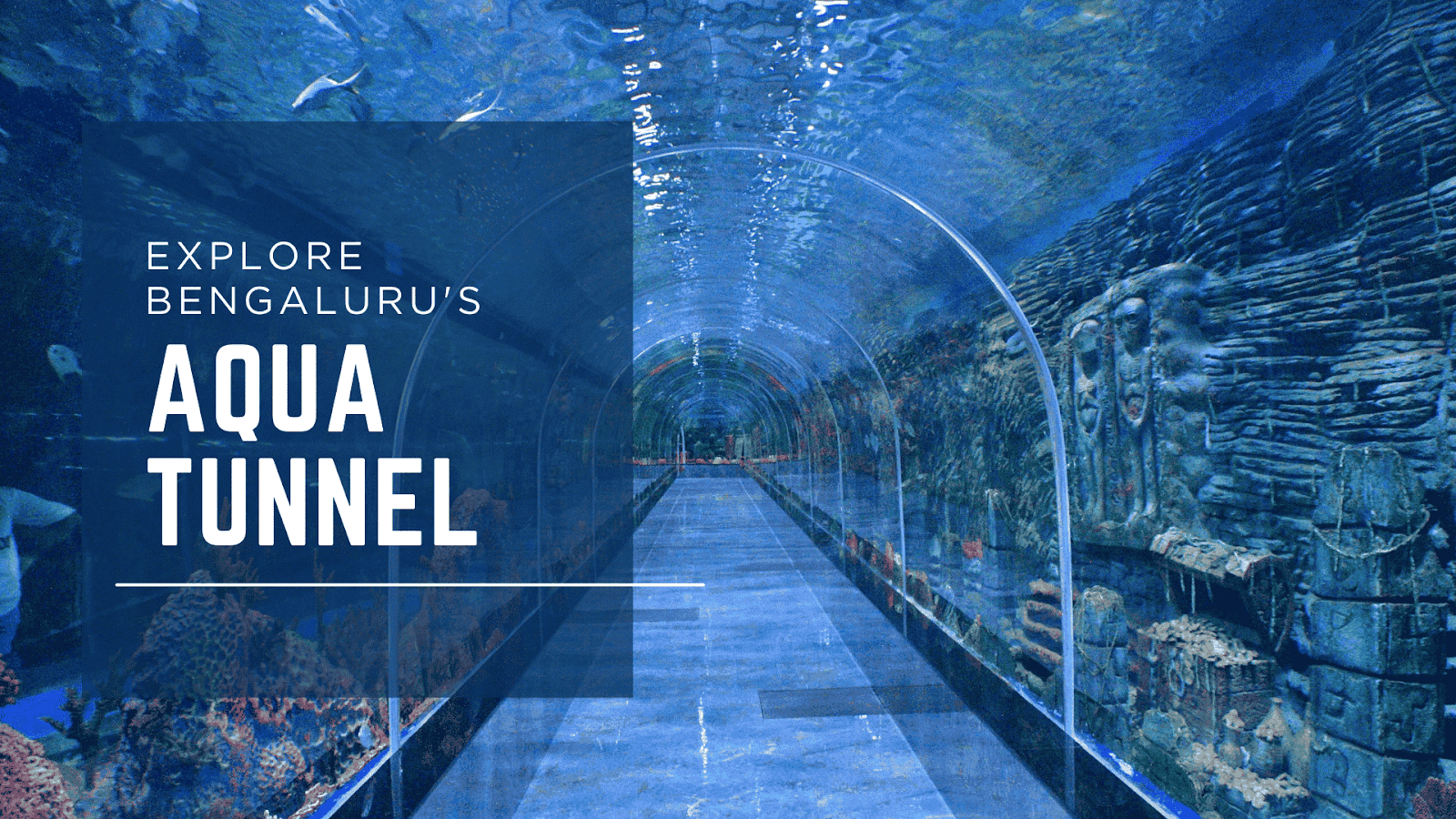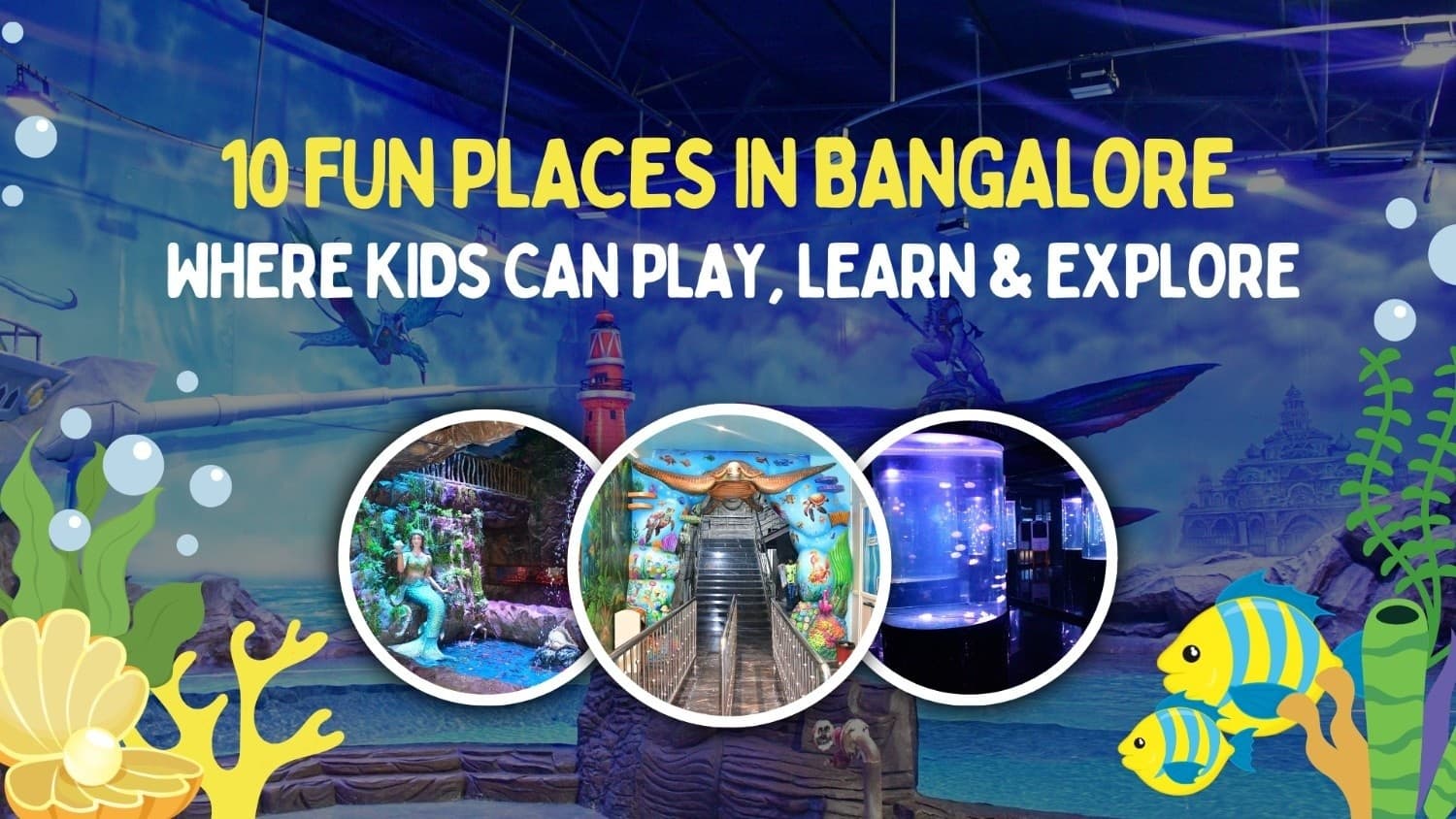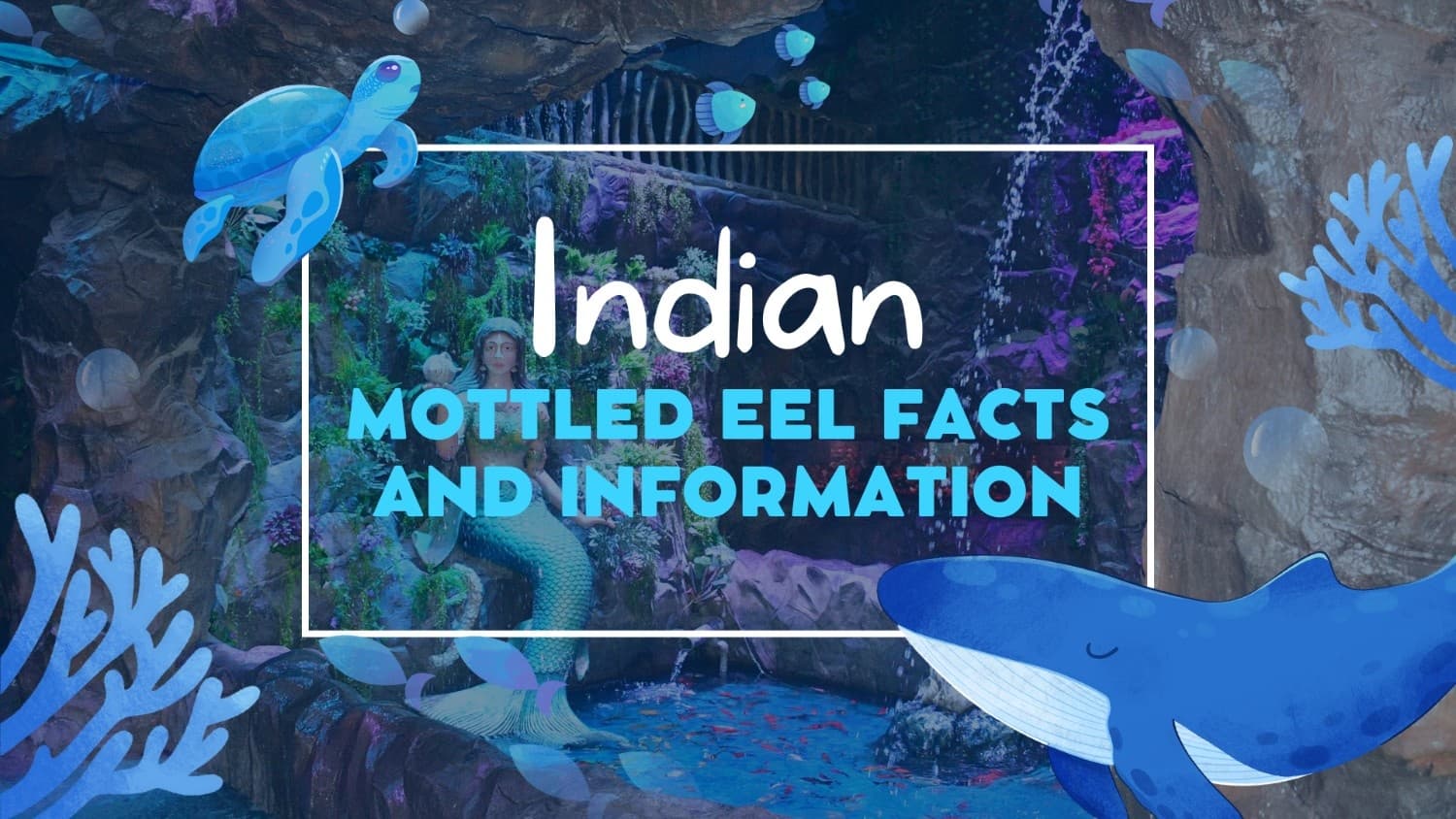Table of Contents
What Is the Indian Mottled Eel?
Growth Stages and Migration Journey of the Indian Mottled Eel
Conservation Status and Threats of the Indian Mottled Eel
Where to See the Indian Mottled Eel in India
FAQs
Indian Mottled Eel Facts and Information
Discover the Indian Mottled Eel (Anguilla bengalensis). Learn about its habitat, migration, and cultural significance, and see it up close in India’s largest aquarium.
The Indian Mottled Eel (Anguilla bengalensis bengalensis) is a truly fascinating fish that looks more like a snake than a typical freshwater species. With its mottled brown-green skin and long, slender body, it stands out instantly. But what makes it even more interesting is its incredible migration journey, spending most of its life in rivers and lakes before travelling all the way to the sea to breed.
Known for its resilience and cultural significance, the Indian Mottled Eel has been part of myths, food traditions, and ecological balance for centuries. Let’s dive into its world and uncover the unique traits that make this eel so special.
In this guide, we’ll explore everything you need to know about the Indian Mottled Eel, its habitat, adaptations, diet, cultural significance, and the threats it faces in the modern world.
TL;DR
- The Indian Mottled Eel (Anguilla bengalensis) is a long-bodied freshwater eel famous for its mottled skin and unique migration journey.
- It can survive in both freshwater and seawater, thanks to its adaptability and skin-breathing ability.
- At Aquarium Paradise in Bangalore, you can see the eel in a habitat that reflects its natural environment.
- Other highlights include River Stingrays, Silver Arowana, Flowerhorn Cichlids, and India’s longest underwater tunnel.
- The eel isn’t just a biological wonder but also holds cultural importance in Indian traditions and cuisine.
- Plan your visit to Aquarium Paradise to discover the mystery and charm of this fascinating species alongside dozens of other aquatic marvels.
What Is the Indian Mottled Eel?
The Indian Mottled Eel (Anguilla bengalensis bengalensis) is a freshwater eel native to South and Southeast Asia. Unlike ordinary fish, this species has an elongated, snake-like body with mottled patterns that help it blend into its surroundings. It’s one of the most well-known freshwater eels in India, found in rivers, lakes, and even paddy fields.
Scientific Identity of the Indian Mottled Eel
The Indian Mottled Eel (Anguilla bengalensis bengalensis) is a fascinating freshwater species that belongs to the family Anguillidae, a group known for its unique migratory life cycles. With its elongated body and distinctive mottled skin, this eel stands out as one of the most remarkable aquatic creatures native to South Asia.
Key Identification Features:
- Scientific Name: Anguilla bengalensis bengalensis, a subspecies of the giant mottled eel.
- Body Shape: Long, snake-like body that helps it move efficiently in rivers, muddy bottoms, and tight spaces.
- Skin Pattern: Brown and green mottled patches across the body, giving natural camouflage in freshwater habitats.
- Head and Mouth: Wide head with a large mouth and fine teeth designed to grip slippery prey like fish and crustaceans.
- Size: Can reach up to 1.2 meters in length and weigh more than 6 kg, making it one of the larger freshwater eels.
- Fins: Continuous dorsal, caudal, and anal fins create smooth, wave-like swimming movements.
- Unique Adaptation: Survives in both freshwater and brackish waters, showing exceptional environmental flexibility.
Diet and Feeding Habits of the Indian Mottled Eel
The Indian Mottled Eel is a nocturnal predator with a diet that shifts as it grows, making it an important player in aquatic food webs.
- Carnivorous Diet: Juveniles feed on small crustaceans, insects, and larvae, while adults consume fish, frogs, and other aquatic organisms.
- Nocturnal Feeding: They are most active at night, using their sharp teeth and strong jaws to ambush prey.
- Opportunistic Predators: Known to adapt their diet based on availability, ensuring survival in changing environments.
- Ecosystem Role: By regulating populations of smaller aquatic species, they help maintain ecological balance.
- Cultural Note: In many regions, their feeding activity aligns with traditional fishing practices, as locals set traps at night to catch them.
Native Range and Distribution of the Indian Mottled Eel
Unlike many freshwater species limited to small pockets, this eel seamlessly connects rivers, lakes, and even coastal waters. Its ability to move between fresh and brackish environments makes it one of the most adaptable freshwater eels in the region.
Key Distribution Insights:
- Geographic Spread: Found across India, Sri Lanka, Bangladesh, Nepal, Myanmar, Thailand, and parts of Indonesia, making it one of the most widespread eel species in South and Southeast Asia.
- Indian Presence: In India, it is commonly spotted in major river systems like the Ganges, Brahmaputra, Godavari, and Cauvery, as well as in Kerala’s backwaters.
- Habitat Flexibility: The eel moves between rivers, lakes, reservoirs, and brackish estuaries, adapting well to both freshwater and saline conditions.
- Migratory Nature: A catadromous species, it spends most of its life in freshwater but migrates to the sea to spawn, completing an extraordinary journey.
- Altitude Range: Can live from lowland rivers up to hilly streams, showing remarkable adaptability across elevations.
- Seasonal Presence: Becomes more active and visible during the monsoon season, when water levels rise and food availability increases.
Growth Stages and Migration Journey of the Indian Mottled Eel
The Indian Mottled Eel has one of the most fascinating and complex life cycles in the freshwater world. Like other true eels of the genus Anguilla, it is catadromous, meaning it spends most of its life in freshwater but migrates to the ocean to spawn. This unique cycle has intrigued researchers and continues to highlight the eel’s adaptability and resilience.
- Spawning Grounds: Indian Mottled Eels are believed to spawn in the deep waters of the Indian Ocean. However, the exact locations are still unknown, much like the mystery surrounding European and American eels.
- Leptocephalus Larvae: After hatching, eel larvae (called leptocephali) are transparent, leaf-shaped, and drift with ocean currents for several months before approaching coastal waters.
- Glass Eel Stage: Once near estuaries, the larvae transform into glass eels, slender, transparent forms capable of swimming upstream into rivers and lakes.
- Elver to Adult Growth: Over time, glass eels become pigmented and enter the elver stage, gradually growing into yellow eels in freshwater habitats. Adults can reach over a meter in length, with a mottled brown appearance for camouflage.
- Return Migration: After spending 10–20 years in rivers, mature eels (known as silver eels) undergo physical changes, including enlarged eyes and stronger muscles, to prepare for their long migration back to the ocean to reproduce.
Life Cycle Timeline of the Indian Mottled Eel
- Eggs → Laid in deep ocean waters
- Leptocephalus Larvae → Transparent, drifting with ocean currents
- Glass Eel → Transparent stage, entering estuaries
- Elver → Pigmented juvenile moving upstream
- Yellow Eel (Adult Growth) → Lives in rivers/lakes for 10–20 years
- Silver Eel → Mature, migrates back to the ocean for spawning
This epic migration cycle not only ensures species survival but also plays a vital role in nutrient exchange between marine and freshwater ecosystems.
Aquatic Environments of the Indian Mottled Eel
The Indian Mottled Eel is highly adaptable when it comes to habitat, which is one reason for its survival across such a vast range. From quiet inland rivers to bustling estuaries, it can thrive in many different aquatic environments.
Where the Indian Mottled Eel Thrives:
- Freshwater Rivers & Streams: Prefers slow-moving rivers and muddy-bottomed streams, where it can easily burrow and hunt for prey.
- Lakes & Reservoirs: Commonly found in large lakes and man-made reservoirs, where stable water bodies provide long-term shelter.
- Estuaries & Brackish Waters: Can tolerate salinity fluctuations and are often found in estuarine regions, especially before migration.
- Seasonal Floodplains: During the monsoons, it spreads into flooded paddy fields and wetlands, feeding on smaller aquatic organisms.
- Burrowing Habit: Known to burrow into mud or hide among vegetation, especially during dry seasons, to conserve energy and avoid predators.
- Night Activity: Primarily nocturnal, preferring to feed and move around under the cover of darkness.
Adaptability and Facultative Catadromy of the Indian Mottled Eel
One of the most fascinating traits of the Indian Mottled Eel is its remarkable adaptability. Unlike some species with rigid life cycles, this eel shows facultative catadromy, meaning it can adjust its migration and habitat use depending on local conditions. This flexibility has allowed the species to survive in diverse environments and thrive across Asia.
- Freshwater and Brackish Tolerance: Indian Mottled Eels can live in rivers, ponds, lakes, and even estuarine waters, shifting habitats as needed.
- Facultative Migration: While many migrate back to the ocean to spawn, some populations adapt by spending extended periods in freshwater or brackish waters, delaying or modifying their migration.
- Survival in Harsh Conditions: Their ability to tolerate low oxygen levels and varied salinity makes them resilient in environments where other fish might struggle.
- Energy Conservation: Their flexible movement between habitats ensures they maximize available food resources and conserve energy for growth and eventual reproduction.
This adaptability not only boosts their survival but also explains their wide presence in Indian aquatic ecosystems.
Role in Ecosystem and Importance of the Indian Mottled Eel
The Indian Mottled Eel contributes greatly to the health and balance of aquatic systems. Its unique position as both predator and prey makes it a keystone species in many freshwater habitats.
- Predator Control: By feeding on smaller fish, frogs, crustaceans, and insects, it keeps these populations in check and prevents ecological imbalance.
- Nutrient Cycling: The eel’s migratory lifestyle, moving between freshwater and marine environments, helps transfer nutrients across ecosystems. This natural movement supports fertility in both river and coastal habitats.
- Prey for Larger Species: Despite being a strong predator, mottled eels are also hunted by birds, crocodiles, and humans, making them an important food source in the natural food web.
- Human Value: The eel has cultural, medicinal, and culinary importance in several Asian regions. In India, it is often used in traditional cooking and is valued for its nutritional benefits.
- Indicator of Ecosystem Health: Healthy eel populations usually signal clean, well-functioning water systems, making them an important bio-indicator species.
Together, these roles highlight why conserving the Indian Mottled Eel is vital not only for biodiversity but also for the communities that depend on it.
Spawning and Reproduction of the Indian Mottled Eel
The reproductive cycle of the Indian Mottled Eel is one of the most intriguing aspects of its biology. Like other eel species, it follows a catadromous pattern, migrating long distances to spawn in the sea.
- Spawning Grounds: While exact locations are still uncertain, scientists believe Indian mottled eels travel to deep ocean waters near the Indian Ocean to reproduce.
- Timing: Spawning typically occurs during monsoon-linked migrations, when rising water levels and strong currents help guide eels toward the sea.
- Eggs and Larvae: Female eels release thousands of eggs that hatch into transparent, leaf-shaped larvae called leptocephali, which drift with ocean currents.
- Juvenile Transformation: These larvae eventually transform into glass eels and migrate back toward rivers and inland waters, completing the life cycle.
- Single-Spawning Species: Like other anguillid eels, the Indian mottled eel spawns only once in its lifetime before dying, a strategy that ensures genetic renewal.
This remarkable journey from rivers to the open ocean and back again makes the Indian Mottled Eel a true symbol of endurance and natural mystery.
Conservation Status and Threats of the Indian Mottled Eel
The Indian Mottled Eel is not currently listed as endangered, but growing pressures on its population cannot be ignored.
- Overfishing: The species is heavily harvested for local consumption and export, especially during migration seasons when they are easier to catch.
- Habitat Barriers: Dams, barrages, and other river modifications disrupt their natural migratory routes, preventing them from reaching spawning grounds.
- Pollution: Industrial runoff, pesticides, and declining water quality in rivers and estuaries reduce survival rates, particularly for juveniles.
- Climate Change: Shifting rainfall patterns and changing ocean currents may further disrupt migration and breeding cycles.
- Conservation Need: Focused research, sustainable fishing practices, and captive breeding programs are urgently required to ensure long-term survival.
Conservation Efforts in India
In India, awareness of the Indian Mottled Eel’s ecological and cultural value is slowly increasing. A few state fisheries departments have initiated breeding and restocking programs, while researchers are studying their migration to better manage river systems. There is also growing interest in community-based conservation, encouraging local fishers to adopt sustainable harvest practices. Although still at an early stage, these steps mark the beginning of efforts to protect this remarkable species for future generations.
If you’ve ever been curious about the mysterious Indian Mottled Eel (Anguilla bengalensis), Aquarium Paradise in Bangalore offers the perfect chance to see it up close. With its elongated, mottled body, slippery skin, and secretive lifestyle, the eel is one of the most intriguing freshwater species you’ll come across.
Where to See the Indian Mottled Eel in India
At Aquarium Paradise, the Indian Mottled Eel is showcased in a naturalistic setup that reflects its riverside and muddy habitat. Visitors can observe its remarkable adaptations, like the ability to breathe through skin, migrate long distances, and thrive in both freshwater and coastal waters. The display not only makes for a fascinating encounter but also helps highlight its ecological importance and cultural value.
But the mottled eel is only one part of the experience. Aquarium Paradise houses over 65 freshwater and saltwater species, creating a complete under-the-sea journey for nature enthusiasts. Some highlights include:
- Silver Arowana: Sleek, intelligent predators with stunning swimming movements.
- River Stingrays: Graceful bottom-dwellers that glide effortlessly along the tank floor.
- Flowerhorn Cichlid: Vibrant fish with unique head shapes and striking colours.
- Giant Gourami: Calm giants that dominate community tanks with their size and presence.
- Blood Red Parrot Fish: Brilliant hybrids with dazzling red-orange hues.
Other Attractions at Aquarium Paradise
- Underwater Tunnel: India’s longest 180-foot ocean tunnel, giving a breathtaking 360° view of sharks, rays, and schools of fish.
- Mermaid Show: Live underwater performances that bring a touch of magic for kids and adults alike.
- Jellyfish Room: A glowing, dreamlike chamber filled with mesmerizing jellyfish displays.
- Ocean Window Lounge: A dining spot with panoramic aquarium views, perfect for families and couples.
- Interactive Feeding Sessions: Watch and even participate as staff explain the feeding habits of fascinating species like eels, koi, and stingrays.
Conclusion
The Indian Mottled Eel is more than just another freshwater species—it’s a symbol of resilience, migration, and adaptability. From its ability to breathe through skin to its fascinating life cycle that spans rivers and oceans, this eel tells a story of survival and mystery.
At Aquarium Paradise, you can witness this incredible fish in a thoughtfully designed habitat while also exploring a world of exotic species and captivating attractions. Whether you’re drawn to ancient eels, enchanted by glowing jellyfish, or intrigued by immersive tunnels, there’s something unforgettable waiting for you.
Plan your visit today to see the Indian Mottled Eel and many other aquatic marvels under one roof. Book your tickets online to skip queues and enjoy exclusive offers for a seamless experience.
FAQs
1. What makes the Indian Mottled Eel unique?
The Indian Mottled Eel is known for its mottled skin, long body, and fascinating ability to migrate between freshwater and seawater. It can also breathe through its skin, making it highly adaptable.
2. Can visitors see the Indian Mottled Eel at Aquarium Paradise?
Yes. Aquarium Paradise in Bangalore houses the Indian Mottled Eel in a special habitat designed to mirror its natural environment, giving visitors a close look at this mysterious species.
3. Are Indian Mottled Eels dangerous to humans?
No, they are not dangerous to humans. While they are slippery and strong, they pose no threat and are safe to observe in aquarium settings.
4. Why are Indian Mottled Eels culturally significant?
In India and Southeast Asia, the eel is often linked to traditional cuisines and local folklore. Its resilience and unique migration journey make it a symbol of endurance.
5. What other species can I see along with the Indian Mottled Eel at Aquarium Paradise?
Apart from the eel, you’ll find species like Silver Arowana, River Stingrays, Blood Red Parrot Fish, Flowerhorn Cichlids, and many more, along with attractions like the underwater tunnel and jellyfish room.
More To Read

6.17.2025
Top 10 Largest Crab Species Worldwide
Compare the largest crab in the world like the Japanese Spider and Coconut Crab. Explore traits, habitats, and conservation efforts. Click to know more!

5.22.2025
Explore the Mesmerizing Aqua Tunnel in Bengaluru
Discover Bengaluru's Aqua Tunnel, a top tourist spot with stunning aquatic displays and interactive experiences. Plan your visit today!

5.16.2025
Mesmerising Little Mermaid Shows Near You
Discover the magic of Aquarium Paradise in Bangalore with its unique underwater tunnel, mermaid show, and interactive marine experiences. Get more info here.

9.4.2025
10 Fun Places in Bangalore Where Kids Can Play, Learn & Explore
Find the best kids fun places near you in Bangalore! Explore activities that blend play, learning, and family time for a perfect day out.

